Code
source("../dsan-globals/_globals.r")DSAN 5000: Data Science and Analytics
source("../dsan-globals/_globals.r")| \(F_1\) | \(F_2\) | \(F_3\) |
|---|---|---|
| 0.8 | 0.9 | 0.1 |
| 0.6 | 0.4 | 0.1 |
→
| \(F_1\) | \(F_2\) | \(F_3\) |
|---|---|---|
| 0.8 | 0.9 | 0.1 |
| 0.6 | 0.4 | 0.1 |
→
| \(F_1\) | \(F_3\) |
|---|---|
| 0.8 | 0.1 |
| 0.6 | 0.1 |
| \(F_1\) | \(F_2\) | \(F_3\) |
|---|---|---|
| 0.8 | 0.9 | 0.1 |
| 0.6 | 0.4 | 0.1 |
→
\[ \begin{align*} {\color{#56b4e9}F'_{12}} &= \frac{{\color{#e69f00}F_1} + {\color{#e69f00}F_2}}{2} \\ {\color{#56b4e9}F'_{23}} &= \frac{{\color{#e69f00}F_2} + {\color{#e69f00}F_3}}{2} \end{align*} \]
→
| \(F'_{12}\) | \(F'_{23}\) |
|---|---|
| 0.85 | 0.50 |
| 0.50 | 0.25 |
library(readr)
library(ggplot2)
gdp_df <- read_csv("assets/gdp_pca.csv")
dist_to_line <- function(x0, y0, a, c) {
numer <- abs(a * x0 - y0 + c)
denom <- sqrt(a * a + 1)
return(numer / denom)
}
# Finding PCA line for industrial vs. exports
x <- gdp_df$industrial
y <- gdp_df$exports
lossFn <- function(lineParams, x0, y0) {
a <- lineParams[1]
c <- lineParams[2]
return(sum(dist_to_line(x0, y0, a, c)))
}
o <- optim(c(0, 0), lossFn, x0 = x, y0 = y)
ggplot(gdp_df, aes(x = industrial, y = exports)) +
geom_point(size=g_pointsize/2) +
geom_abline(aes(slope = o$par[1], intercept = o$par[2], color="pca"), linewidth=g_linewidth, show.legend = TRUE) +
geom_smooth(aes(color="lm"), method = "lm", se = FALSE, linewidth=g_linewidth, key_glyph = "blank") +
scale_color_manual(element_blank(), values=c("pca"=cbPalette[2],"lm"=cbPalette[1]), labels=c("Regression","PCA")) +
dsan_theme("half") +
remove_legend_title() +
labs(
title = "PCA Line vs. Regression Line",
x = "Industrial Production (% of GDP)",
y = "Exports (% of GDP)"
)
ggplot(gdp_df, aes(pc1, .fittedPC2)) +
geom_point(size = g_pointsize/2) +
geom_hline(aes(yintercept=0, color='PCA Line'), linetype='solid', size=g_linesize) +
geom_rug(sides = "b", linewidth=g_linewidth/1.2, length = unit(0.1, "npc"), color=cbPalette[3]) +
expand_limits(y=-1.6) +
scale_color_manual(element_blank(), values=c("PCA Line"=cbPalette[2])) +
dsan_theme("half") +
remove_legend_title() +
labs(
title = "Exports vs. Industry in Principal Component Space",
x = "First Principal Component (Axis of Greatest Variance)",
y = "Second PC"
)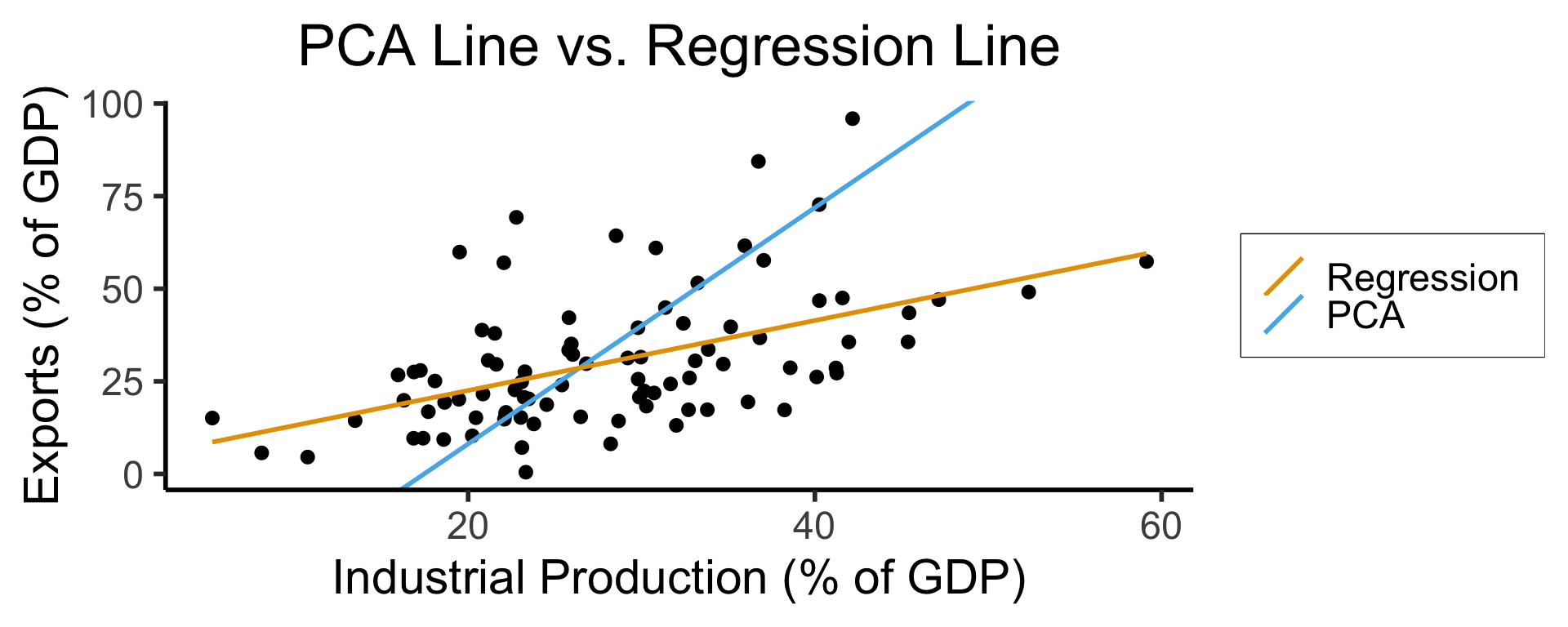
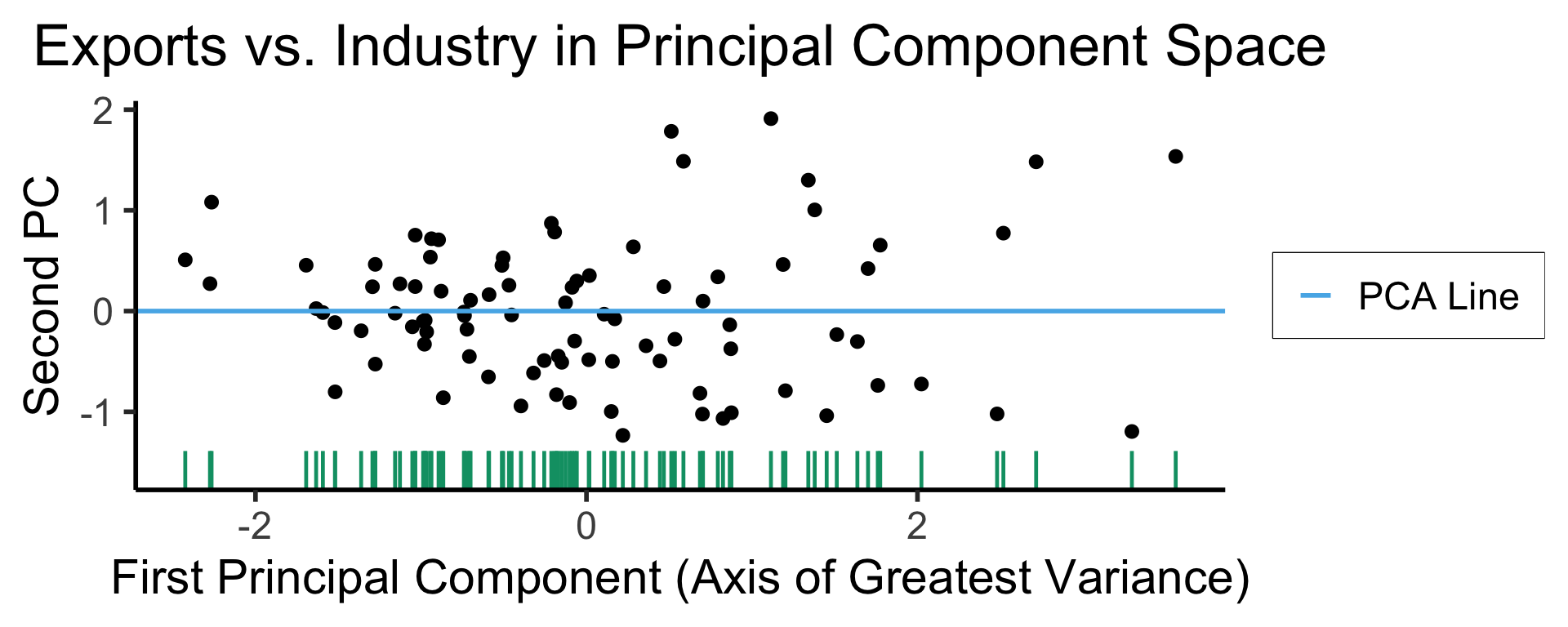
library(dplyr)
library(tidyr)
plot_df <- gdp_df %>% select(c(country_code, pc1, agriculture, military))
long_df <- plot_df %>% pivot_longer(!c(country_code, pc1), names_to = "var", values_to = "val")
long_df <- long_df |> mutate(
var = case_match(
var,
"agriculture" ~ "Agricultural Production",
"military" ~ "Military Spending"
)
)
ggplot(long_df, aes(x = pc1, y = val, facet = var)) +
geom_point() +
facet_wrap(vars(var), scales = "free") +
dsan_theme("full") +
labs(
x = "Industrial-Export Dimension (First Principal Component)",
y = "% of GDP"
)
library(tidyverse)
library(MASS)
library(ggforce)
N <- 300
Mu <- c(0, 0)
var_x <- 3
var_y <- 1
Sigma <- matrix(c(var_x, 0, 0, var_y), nrow=2)
data_df <- as_tibble(mvrnorm(N, Mu, Sigma, empirical=TRUE))
colnames(data_df) <- c("x","y")
# data_df <- data_df |> mutate(
# within_5 = x < 5,
# within_sq5 = x < sqrt(5)
# )
#nrow(data_df |> filter(within_5)) / nrow(data_df)
#nrow(data_df |> filter(within_sq5)) / nrow(data_df)
# And plot
ggplot(data_df, aes(x=x, y=y)) +
# 68% ellipse
# stat_ellipse(geom="polygon", type="norm", linewidth=g_linewidth, level=0.68, fill=cbPalette[1], alpha=0.5) +
# stat_ellipse(type="norm", linewidth=g_linewidth, level=0.68) +
geom_ellipse(
aes(x0=0, y0=0, a=var_x, b=var_y, angle=0),
linewidth = g_linewidth
) +
# geom_ellipse(
# aes(x0=0, y0=0, a=sqrt(5), b=1, angle=0),
# linewidth = g_linewidth,
# geom="polygon",
# fill=cbPalette[1], alpha=0.2
# ) +
# # 95% ellipse
# stat_ellipse(geom="polygon", type="norm", linewidth=g_linewidth, level=0.95, fill=cbPalette[1], alpha=0.25) +
# stat_ellipse(type="norm", linewidth=g_linewidth, level=0.95) +
# # 99.7% ellipse
# stat_ellipse(geom='polygon', type="norm", linewidth=g_linewidth, level=0.997, fill=cbPalette[1], alpha=0.125) +
# stat_ellipse(type="norm", linewidth=g_linewidth, level=0.997) +
# Lines at x=0 and y=0
geom_vline(xintercept=0, linetype="dashed", linewidth=g_linewidth / 2) +
geom_hline(yintercept=0, linetype="dashed", linewidth = g_linewidth / 2) +
geom_point(
size = g_pointsize / 3,
#alpha=0.5
) +
geom_rug(length=unit(0.5, "cm"), alpha=0.75) +
geom_segment(
aes(x=-var_x, y=0, xend=var_x, yend=0, color='PC1'),
linewidth = 1.5 * g_linewidth,
arrow = arrow(length = unit(0.1, "npc"))
) +
geom_segment(
aes(x=0, y=-var_y, xend=0, yend=var_y, color='PC2'),
linewidth = 1.5 * g_linewidth,
arrow = arrow(length = unit(0.1, "npc"))
) +
dsan_theme("half") +
coord_fixed() +
remove_legend_title() +
scale_color_manual(
"PC Vectors",
values=c('PC1'=cbPalette[1], 'PC2'=cbPalette[2])
) +
scale_x_continuous(breaks=seq(-5,5,1), limits=c(-5,5))── Attaching core tidyverse packages ──────────────────────── tidyverse 2.0.0 ──
✔ forcats 1.0.0 ✔ stringr 1.5.1
✔ lubridate 1.9.3 ✔ tibble 3.2.1
✔ purrr 1.0.2
── Conflicts ────────────────────────────────────────── tidyverse_conflicts() ──
✖ dplyr::filter() masks stats::filter()
✖ dplyr::lag() masks stats::lag()
ℹ Use the conflicted package (<http://conflicted.r-lib.org/>) to force all conflicts to become errors
Attaching package: 'MASS'
The following object is masked from 'package:dplyr':
selectWarning: The `x` argument of `as_tibble.matrix()` must have unique column names if
`.name_repair` is omitted as of tibble 2.0.0.
ℹ Using compatibility `.name_repair`.Warning in geom_segment(aes(x = -var_x, y = 0, xend = var_x, yend = 0, color = "PC1"), : All aesthetics have length 1, but the data has 300 rows.
ℹ Please consider using `annotate()` or provide this layer with data containing
a single row.Warning in geom_segment(aes(x = 0, y = -var_y, xend = 0, yend = var_y, color = "PC2"), : All aesthetics have length 1, but the data has 300 rows.
ℹ Please consider using `annotate()` or provide this layer with data containing
a single row.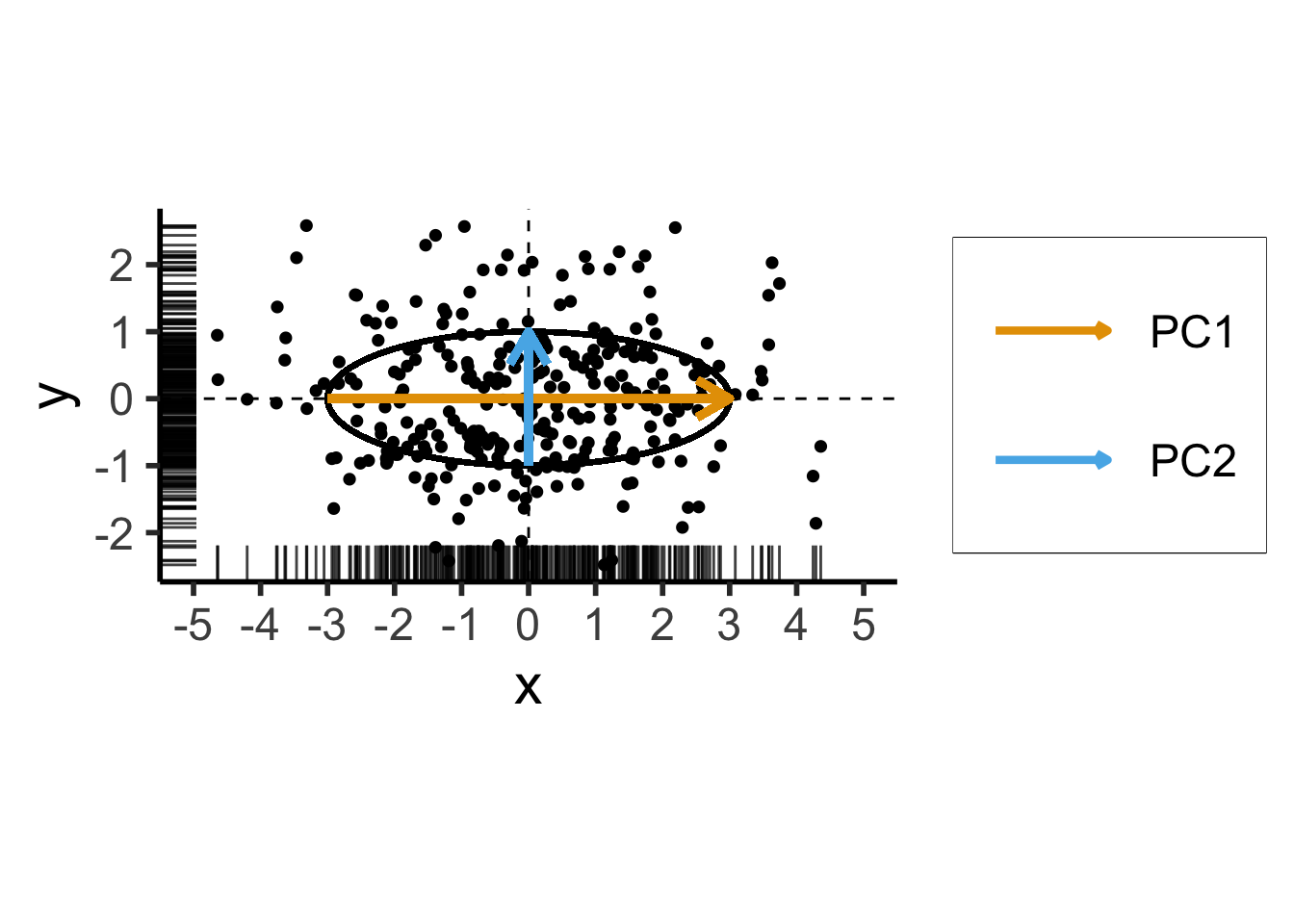
\[ \mathbf{\Sigma} = \begin{bmatrix} {\color{#e69f00}3} & 0 \\ 0 & {\color{#56b4e9}1} \end{bmatrix} \]
Two solutions to \(\mathbf{\Sigma}\mathbf{x} = \lambda \mathbf{x}\):
library(tidyverse)
library(MASS)
N <- 250
Mu <- c(0,0)
Sigma <- matrix(c(2,1,1,2), nrow=2)
data_df <- as_tibble(mvrnorm(N, Mu, Sigma))
colnames(data_df) <- c("x","y")
# Start+end coordinates for the transformed vectors
pc1_rc <- (3/2)*sqrt(2)
pc2_rc <- (1/2)*sqrt(2)
ggplot(data_df, aes(x=x, y=y)) +
geom_ellipse(
aes(x0=0, y0=0, a=var_x, b=var_y, angle=pi/4),
linewidth = g_linewidth,
#fill='grey', alpha=0.0075
) +
geom_vline(xintercept=0, linetype="dashed", linewidth=g_linewidth / 2) +
geom_hline(yintercept=0, linetype="dashed", linewidth = g_linewidth / 2) +
geom_point(
size = g_pointsize / 3,
#alpha=0.7
) +
geom_rug(
length=unit(0.35, "cm"), alpha=0.75
) +
geom_segment(
aes(x=-pc1_rc, y=-pc1_rc, xend=pc1_rc, yend=pc1_rc, color='PC1'),
linewidth = 1.5 * g_linewidth,
arrow = arrow(length = unit(0.1, "npc"))
) +
geom_segment(
aes(x=pc2_rc, y=-pc2_rc, xend=-pc2_rc, yend=pc2_rc, color='PC2'),
linewidth = 1.5 * g_linewidth,
arrow = arrow(length = unit(0.1, "npc"))
) +
dsan_theme("half") +
remove_legend_title() +
coord_fixed() +
scale_x_continuous(breaks=seq(-4,4,2))Warning in geom_segment(aes(x = -pc1_rc, y = -pc1_rc, xend = pc1_rc, yend = pc1_rc, : All aesthetics have length 1, but the data has 250 rows.
ℹ Please consider using `annotate()` or provide this layer with data containing
a single row.Warning in geom_segment(aes(x = pc2_rc, y = -pc2_rc, xend = -pc2_rc, yend = pc2_rc, : All aesthetics have length 1, but the data has 250 rows.
ℹ Please consider using `annotate()` or provide this layer with data containing
a single row.
\[ \mathbf{\Sigma}' = \begin{bmatrix} 2 & 1 \\ 1 & 2 \end{bmatrix} \]
Still two solutions to \(\mathbf{\Sigma}'\mathbf{x} = \lambda \mathbf{x}\):
For those interested in how we obtained \(\mathbf{\Sigma}'\) with same eigenvalues but different eigenvectors from \(\mathbf{\Sigma}\), see the appendix slide.
Takeaway 1: Regardless of the coordinate system,
If we project each \(X_i\) onto \(N\) principal component axes:
Datapoints in PC space are linear combinations of the original datapoints! (← Takeaway 2a)
\[ X'_i = \alpha_1X_1 + \cdots + \alpha_nX_n, \]
where \(\forall i \left[\alpha_i \neq 0\right]\)
We are just “re-plotting” our original data in PC space via change of coordinates
Thus we can recover the original data from the PC data
If we project \(X_i\) onto \(M < N\) principal component axes:
\[ \text{Perp}(P_i) = 2^{H(P_i)} \]
High perplexity \(\iff\) high entropy (eventually Gaussian ball will grow so big that all other points will be equally likely!). So, vary perplexity, see how plot changes
See here for an absolutely incredible interactive walkthrough of t-SNE!
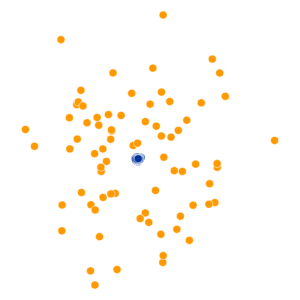
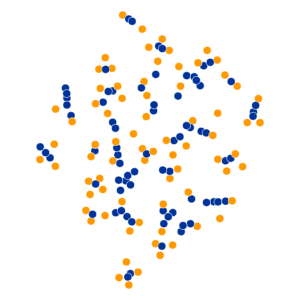
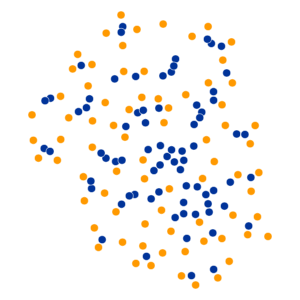

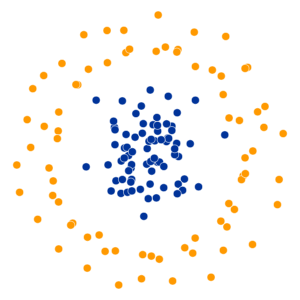
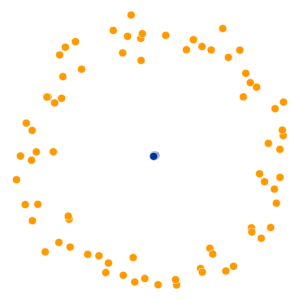
| General Questions | Specific Questions |
|---|---|
| Is it a physical object? | Is it a soda can? |
| Is it an animal? | Is it a cat? |
| Is it bigger than a house? | Is it a planet? |
For linguistics fans: if a word \(x\) is one level “more general” than another word \(y\) (e.g., the word “camel” is one level more general than “bactrian camel”, a camel with two humps), we say that \(x\) is a hypernym of \(y\), and that \(y\) is a hyponym of \(x\). The WordNet project is a big tree of hypernym/hyponym relationships among all English words, where “entity” is the root node of the tree.
| \(\text{Choice}\) | Tree | Bird | Car |
| \(\Pr(\text{Choice})\) | 0.25 | 0.25 | 0.50 |
Example adapted from this essay by Simon DeDeo!
\[ \begin{align*} &\mathbb{E}[\text{\# Moves}] \\ =\,&1 \cdot \Pr(\text{Car}) + 2 \cdot \Pr(\text{Bird}) \\ &+ 2 \cdot \Pr(\text{Tree}) \\ =\,&1 \cdot 0.5 + 2\cdot 0.25 + 2\cdot 0.25 \\ =\,&1.5 \end{align*} \]
\[ \begin{align*} &\mathbb{E}[\text{\# Moves}] \\ =\,&1 \cdot \Pr(\text{Bird}) + 2 \cdot \Pr(\text{Car}) \\ &+ 2 \cdot \Pr(\text{Tree}) \\ =\,&1 \cdot 0.25 + 2\cdot 0.5 + 2\cdot 0.25 \\ =\,&1.75 \end{align*} \]
\[ \begin{align*} &\mathbb{E}[\text{\# Moves}] \\ =\,&1 \cdot \Pr(\text{Bird}) + 3 \cdot \Pr(\text{Car}) \\ &+ 3 \cdot \Pr(\text{Tree}) \\ =\,&1 \cdot 0.25 + 3\cdot 0.5 + 3\cdot 0.25 \\ =\,&2.5 \end{align*} \]
\[ \begin{align*} H(X) &= -\sum_{i=1}^N \Pr(X = i)\log_2\Pr(X = i) \end{align*} \]
\[ \begin{align*} H(X) &= -\left[ \Pr(X = \text{Car}) \log_2\Pr(X = \text{Car}) \right. \\ &\phantom{= -[ } + \Pr(X = \text{Bird})\log_2\Pr(X = \text{Bird}) \\ &\phantom{= -[ } + \left. \Pr(X = \text{Tree})\log_2\Pr(X = \text{Tree})\right] \\ &= -\left[ (0.5)(-1) + (0.25)(-2) + (0.25)(-2) \right] = 1.5~🧐 \end{align*} \]
\[ \begin{align*} \mathbb{E}[\text{\# Moves}] &= 1 \cdot (1/3) + 2 \cdot (1/3) + 2 \cdot (1/3) \\ &= \frac{5}{3} \approx 1.667 \end{align*} \]
\[ \begin{align*} H(X) &= -\left[ \Pr(X = \text{Car}) \log_2\Pr(X = \text{Car}) \right. \\ &\phantom{= -[ } + \Pr(X = \text{Bird})\log_2\Pr(X = \text{Bird}) \\ &\phantom{= -[ } + \left. \Pr(X = \text{Tree})\log_2\Pr(X = \text{Tree})\right] \\ &= -\left[ \frac{1}{3}\log_2\left(\frac{1}{3}\right) + \frac{1}{3}\log_2\left(\frac{1}{3}\right) + \frac{1}{3}\log_2\left(\frac{1}{3}\right) \right] \approx 1.585~🧐 \end{align*} \]
The smallest possible number of levels \(L^*\) for a script based on RV \(X\) is exactly
\[ L^* = \lceil H(X) \rceil \]
Intuition: Although \(\mathbb{E}[\text{\# Moves}] = 1.5\), we cannot have a tree with 1.5 levels!
Entropy provides a lower bound on \(\mathbb{E}[\text{\# Moves}]\):
\[ \mathbb{E}[\text{\# Moves}] \geq H(X) \]
library(tidyverse)
library(lubridate)
sample_size <- 100
day <- seq(ymd('2023-01-01'),ymd('2023-12-31'),by='weeks')
lat_bw <- 5
latitude <- seq(-90, 90, by=lat_bw)
ski_df <- expand_grid(day, latitude)
#ski_df |> head()
# Data-generating process
lat_cutoff <- 35
ski_df <- ski_df |> mutate(
near_equator = abs(latitude) <= lat_cutoff,
northern = latitude > lat_cutoff,
southern = latitude < -lat_cutoff,
first_3m = day < ymd('2023-04-01'),
last_3m = day >= ymd('2023-10-01'),
middle_6m = (day >= ymd('2023-04-01')) & (day < ymd('2023-10-01')),
snowfall = 0
)
# Update the non-zero sections
mu_snow <- 10
sd_snow <- 2.5
# How many northern + first 3 months
num_north_first_3 <- nrow(ski_df[ski_df$northern & ski_df$first_3m,])
ski_df[ski_df$northern & ski_df$first_3m, 'snowfall'] = rnorm(num_north_first_3, mu_snow, sd_snow)
# Northerns + last 3 months
num_north_last_3 <- nrow(ski_df[ski_df$northern & ski_df$last_3m,])
ski_df[ski_df$northern & ski_df$last_3m, 'snowfall'] = rnorm(num_north_last_3, mu_snow, sd_snow)
# How many southern + middle 6 months
num_south_mid_6 <- nrow(ski_df[ski_df$southern & ski_df$middle_6m,])
ski_df[ski_df$southern & ski_df$middle_6m, 'snowfall'] = rnorm(num_south_mid_6, mu_snow, sd_snow)
# And collapse into binary var
ski_df['good_skiing'] = ski_df$snowfall > 0
# This converts day into an int
ski_df <- ski_df |> mutate(
day_num = lubridate::yday(day)
)
#print(nrow(ski_df))
ski_sample <- ski_df |> slice_sample(n = sample_size)
ski_sample |> write_csv("assets/ski.csv")
ggplot(
ski_sample,
aes(
x=day,
y=latitude,
#shape=good_skiing,
color=good_skiing
)) +
geom_point(
size = g_pointsize / 1.5,
#stroke=1.5
) +
dsan_theme() +
labs(
x = "Time of Year",
y = "Latitude",
shape = "Good Skiing?"
) +
scale_shape_manual(name="Good Skiing?", values=c(1, 3)) +
scale_color_manual(name="Good Skiing?", values=c(cbPalette[1], cbPalette[2]), labels=c("No (Sunny)","Yes (Snowy)")) +
scale_x_continuous(
breaks=c(ymd('2023-01-01'), ymd('2023-02-01'), ymd('2023-03-01'), ymd('2023-04-01'), ymd('2023-05-01'), ymd('2023-06-01'), ymd('2023-07-01'), ymd('2023-08-01'), ymd('2023-09-01'), ymd('2023-10-01'), ymd('2023-11-01'), ymd('2023-12-01')),
labels=c("Jan", "Feb", "Mar", "Apr", "May", "Jun", "Jul", "Aug", "Sep", "Oct", "Nov", "Dec")
) +
scale_y_continuous(breaks=c(-90, -60, -30, 0, 30, 60, 90))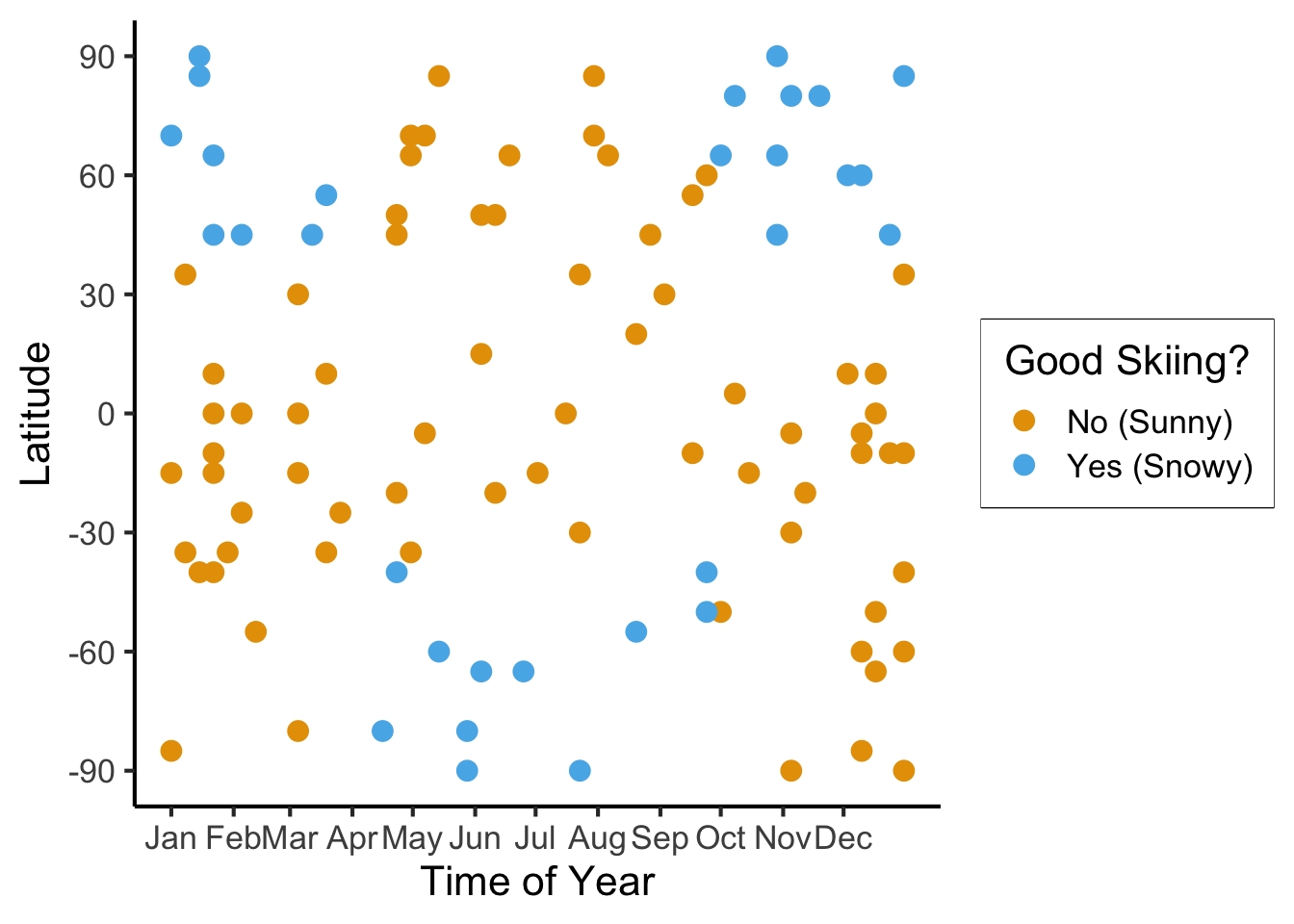
ski_sample |> count(good_skiing)| good_skiing | n |
|---|---|
| FALSE | 70 |
| TRUE | 30 |
\[ \mathscr{L}(R_i) = -\sum_{c}\widehat{p}_c(R_i)\log_2(\widehat{p}_c(R_i)) \]
\[ \mathscr{L}(R_i) = -[(0.66)\log_2(0.66) + (0.34)\log_2(0.34)] \approx 0.925 \]
Let’s think through two choices for the first split:
ski_sample <- ski_sample |> mutate(
lat_lt_475 = latitude <= 47.5
)
ski_sample |> group_by(lat_lt_475) |> count(good_skiing)
ski_sample <- ski_sample |> mutate(
month_lt_oct = day < ymd('2023-10-01')
)
ski_sample |> group_by(month_lt_oct) |> count(good_skiing)\(\text{latitude} \leq -47.5\):
| lat_lt_475 | good_skiing | n |
|---|---|---|
| FALSE | FALSE | 13 |
| FALSE | TRUE | 14 |
| TRUE | FALSE | 57 |
| TRUE | TRUE | 16 |
This gives us the rule
\[ \widehat{C}(x) = \begin{cases} 0 &\text{if }\text{latitude} \leq 47.5, \\ 0 &\text{otherwise} \end{cases} \]
\(\text{month} < \text{October}\)
| month_lt_oct | good_skiing | n |
|---|---|---|
| FALSE | FALSE | 22 |
| FALSE | TRUE | 11 |
| TRUE | FALSE | 48 |
| TRUE | TRUE | 19 |
This gives us the rule
\[ \widehat{C}(x) = \begin{cases} 0 &\text{if }\text{month} < \text{October}, \\ 0 &\text{otherwise} \end{cases} \]
So, if we judge purely on acuracy scores… it seems like we’re not getting anywhere here (but, we know we are getting somewhere!)
import json
import pandas as pd
import numpy as np
import sklearn
from sklearn.tree import DecisionTreeClassifier
sklearn.set_config(display='text')
ski_df = pd.read_csv("assets/ski.csv")
ski_df['good_skiing'] = ski_df['good_skiing'].astype(int)
X = ski_df[['day_num', 'latitude']]
y = ski_df['good_skiing']
dtc = DecisionTreeClassifier(
max_depth = 1,
criterion = "entropy"
)
dtc.fit(X, y);
y_pred = pd.Series(dtc.predict(X), name="y_pred")
result_df = pd.concat([X,y,y_pred], axis=1)
result_df['correct'] = result_df['good_skiing'] == result_df['y_pred']
result_df.to_csv("assets/ski_predictions.csv")
sklearn.tree.plot_tree(dtc, feature_names = X.columns)
n_nodes = dtc.tree_.node_count
children_left = dtc.tree_.children_left
children_right = dtc.tree_.children_right
feature = dtc.tree_.feature
feat_index = feature[0]
feat_name = X.columns[feat_index]
thresholds = dtc.tree_.threshold
feat_threshold = thresholds[0]
#print(f"Feature: {feat_name}\nThreshold: <= {feat_threshold}")
values = dtc.tree_.value
#print(values)
dt_data = {
'feat_index': feat_index,
'feat_name': feat_name,
'feat_threshold': feat_threshold
}
dt_df = pd.DataFrame([dt_data])
dt_df.to_feather('assets/ski_dt.feather')
library(tidyverse)
library(arrow)
# Load the dataset
ski_result_df <- read_csv("assets/ski_predictions.csv")
# Load the DT info
dt_df <- read_feather("assets/ski_dt.feather")
# Here we only have one value, so just read that
# value directly
lat_thresh <- dt_df$feat_threshold
ggplot(ski_result_df, aes(x=day_num, y=latitude, color=factor(good_skiing), shape=correct)) +
geom_point(
size = g_pointsize / 1.5,
stroke = 1.5
) +
geom_hline(
yintercept = lat_thresh,
linetype = "dashed"
) +
dsan_theme("half") +
labs(
x = "Time of Year",
y = "Latitude",
color = "True Class",
#shape = "Correct?"
) +
scale_shape_manual("DT Prediction", values=c(1,3), labels=c("Incorrect","Correct")) +
scale_color_manual("True Class", values=c(cbPalette[1], cbPalette[2]), labels=c("Bad (Sunny)","Good (Snowy)"))
ski_result_df |> count(correct)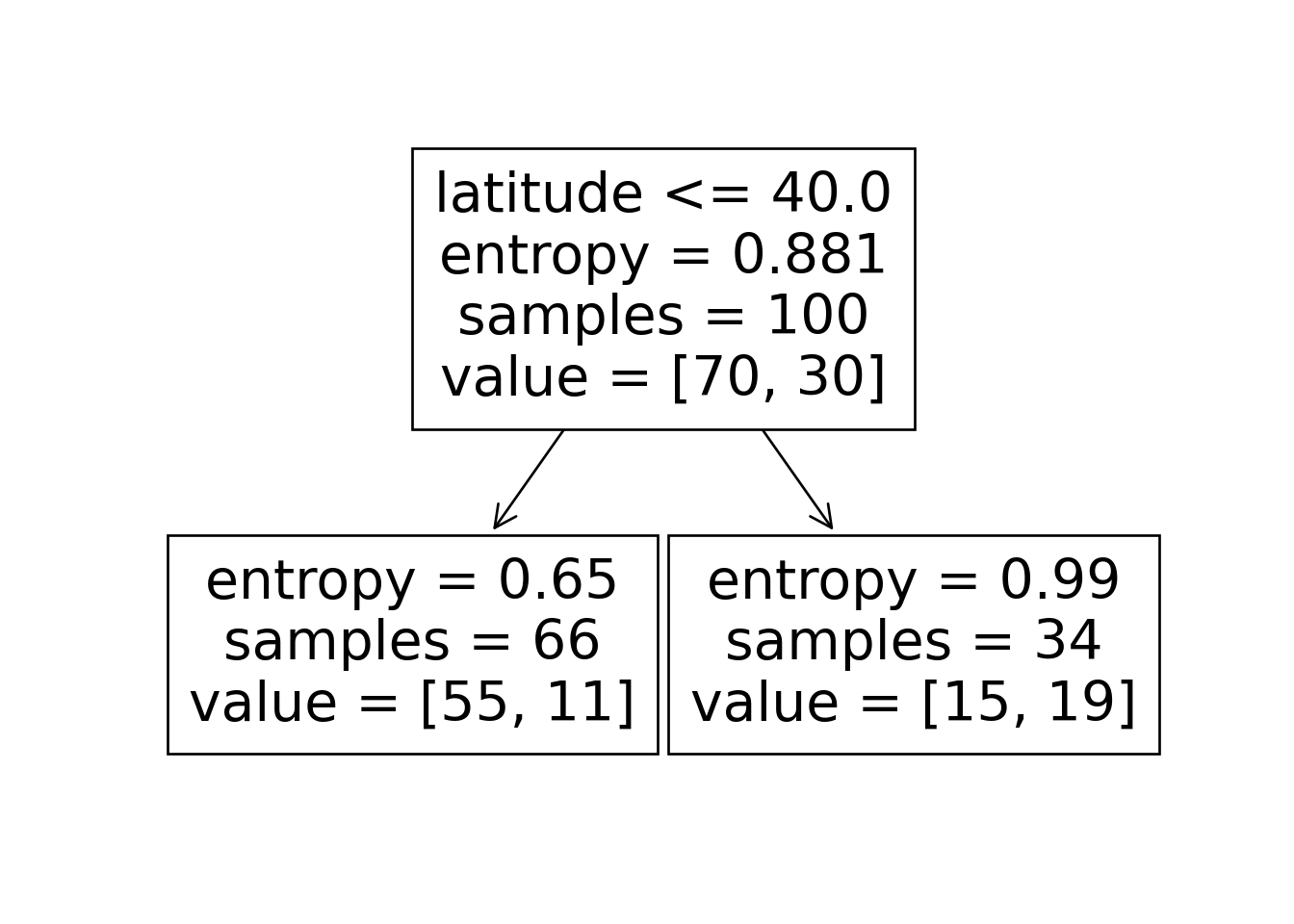
Attaching package: 'arrow'The following object is masked from 'package:lubridate':
durationThe following object is masked from 'package:utils':
timestampNew names:
• `` -> `...1`Rows: 100 Columns: 6
── Column specification ────────────────────────────────────────────────────────
Delimiter: ","
dbl (5): ...1, day_num, latitude, good_skiing, y_pred
lgl (1): correct
ℹ Use `spec()` to retrieve the full column specification for this data.
ℹ Specify the column types or set `show_col_types = FALSE` to quiet this message.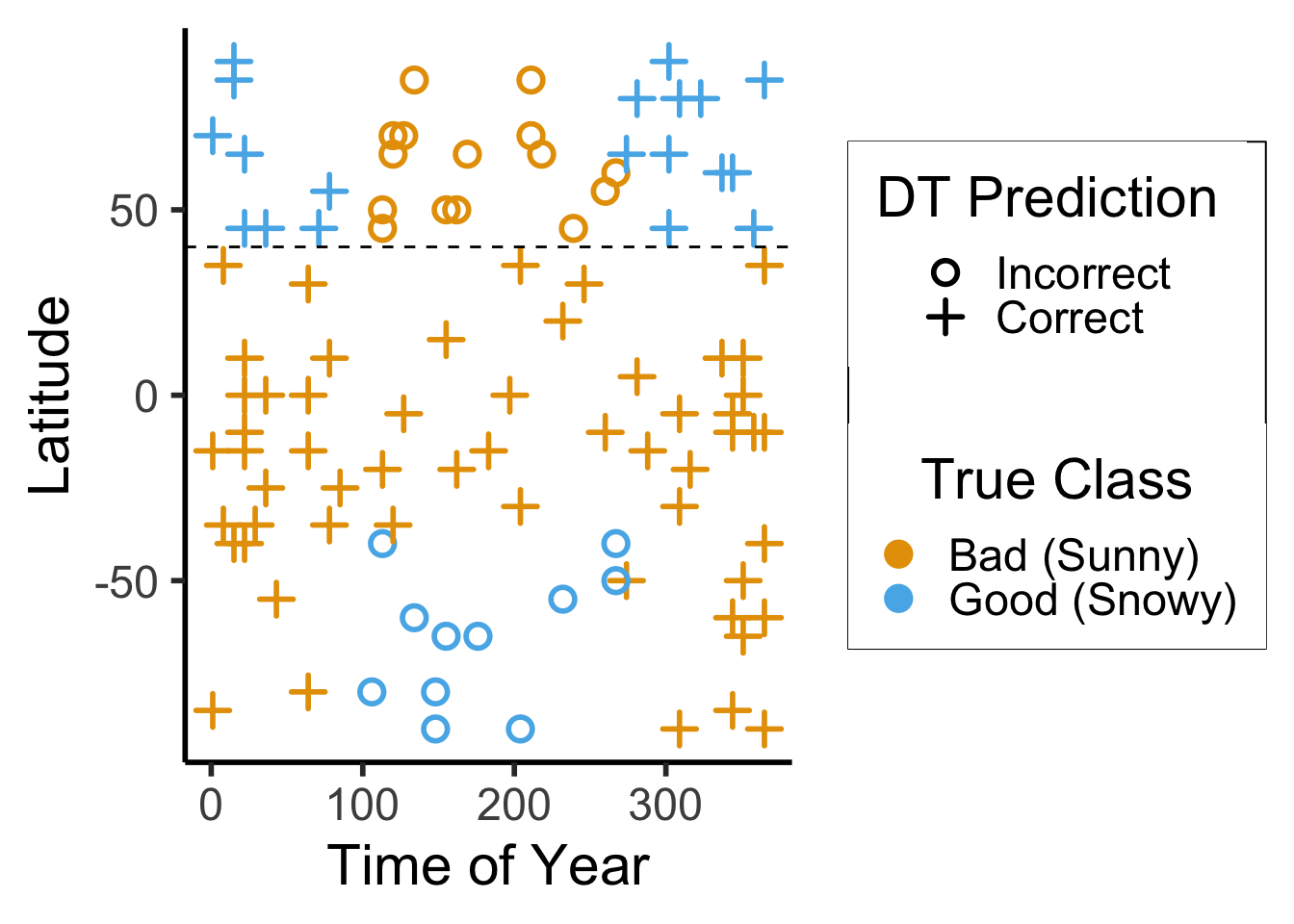
| correct | n |
|---|---|
| FALSE | 26 |
| TRUE | 74 |
\[ \begin{align*} \mathscr{L}(R_1) &= -\left[ \frac{13}{25}\log_2\left(\frac{13}{25}\right) + \frac{12}{25}\log_2\left(\frac{12}{25}\right) \right] \approx 0.999 \\ \mathscr{L}(R_2) &= -\left[ \frac{61}{75}\log_2\left(\frac{61}{75}\right) + \frac{14}{75}\log_2\left(\frac{14}{75}\right) \right] \approx 0.694 \\ %\mathscr{L}(R \rightarrow (R_1, R_2)) &= \Pr(x_i \in R_1)\mathscr{L}(R_1) + \Pr(x_i \in R_2)\mathscr{L}(R_2) \\ \mathscr{L}(R_1, R_2) &= \frac{1}{4}(0.999) + \frac{3}{4}(0.694) \approx 0.77 < 0.827~😻 \end{align*} \]
library(tidyverse)
my_ent <- function(x) -(x * log2(x) + (1-x)*log2(1-x))
loss_df <- tribble(
~x, ~label,
0.5, "L(R1)",
0.9, "L(R2)",
0.7, "L(R)"
)
loss_df <- loss_df |> mutate(
y = my_ent(x)
)
ggplot(data=tibble(x=c(0,1))) +
stat_function(fun=my_ent, linewidth = g_linewidth) +
geom_text(data=loss_df, aes(x=x, y=y, label=label)) +
xlim(c(0,1)) +
dsan_theme("half")Warning: Removed 2 rows containing missing values or values outside the scale range
(`geom_function()`).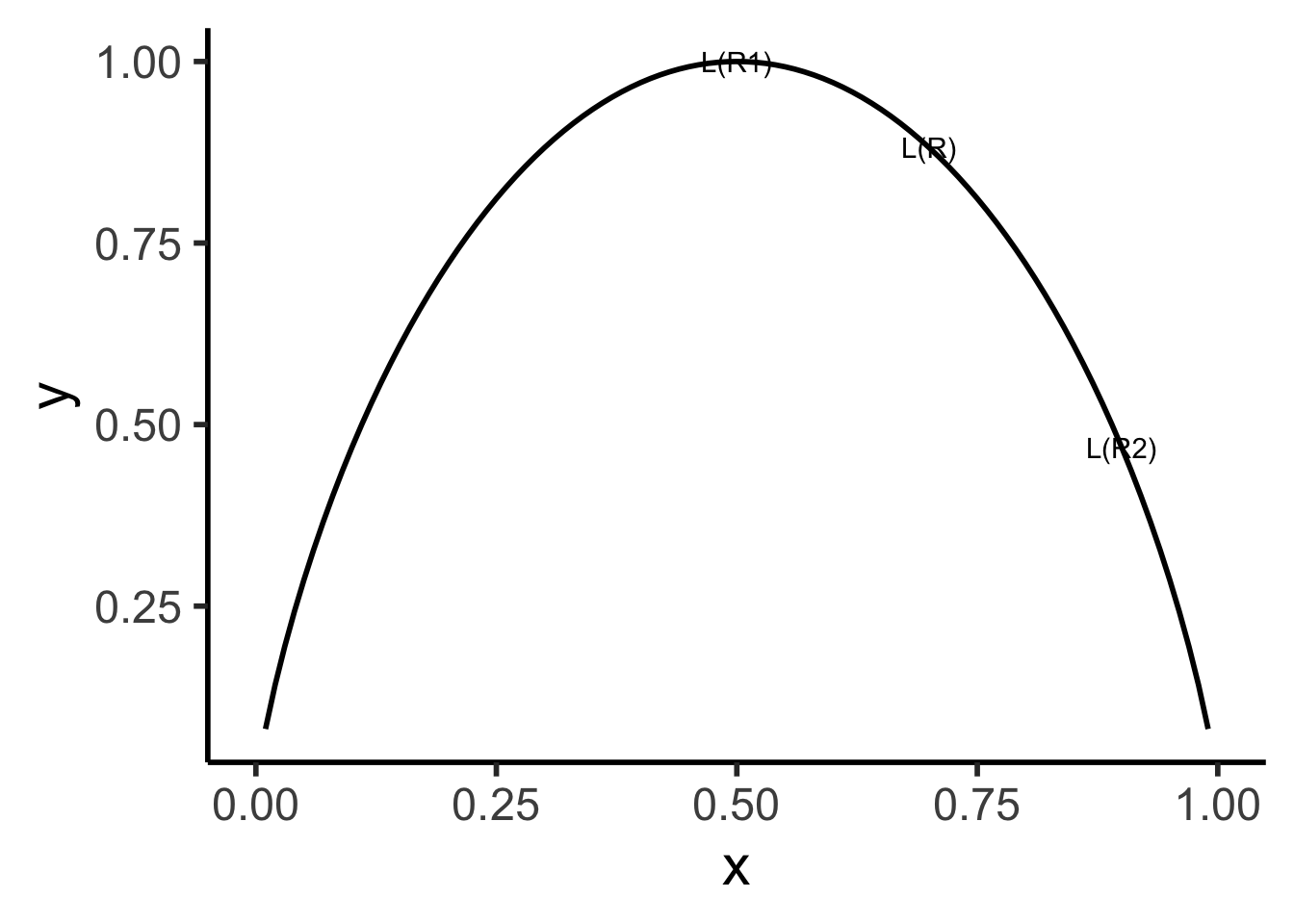
#format_snow <- function(x) sprintf('%.2f', x)
format_snow <- function(x) round(x, 2)
ski_sample['snowfall_str'] <- sapply(ski_sample$snowfall, format_snow)
#ski_df |> head()
#print(nrow(ski_df))
ggplot(ski_sample, aes(x=day, y=latitude, label=snowfall_str)) +
geom_text(size = 6) +
dsan_theme() +
labs(
x = "Time of Year",
y = "Latitude",
shape = "Good Skiing?"
) +
scale_shape_manual(values=c(1, 3)) +
scale_x_continuous(
breaks=c(ymd('2023-01-01'), ymd('2023-02-01'), ymd('2023-03-01'), ymd('2023-04-01'), ymd('2023-05-01'), ymd('2023-06-01'), ymd('2023-07-01'), ymd('2023-08-01'), ymd('2023-09-01'), ymd('2023-10-01'), ymd('2023-11-01'), ymd('2023-12-01')),
labels=c("Jan", "Feb", "Mar", "Apr", "May", "Jun", "Jul", "Aug", "Sep", "Oct", "Nov", "Dec")
) +
scale_y_continuous(breaks=c(-90, -60, -30, 0, 30, 60, 90))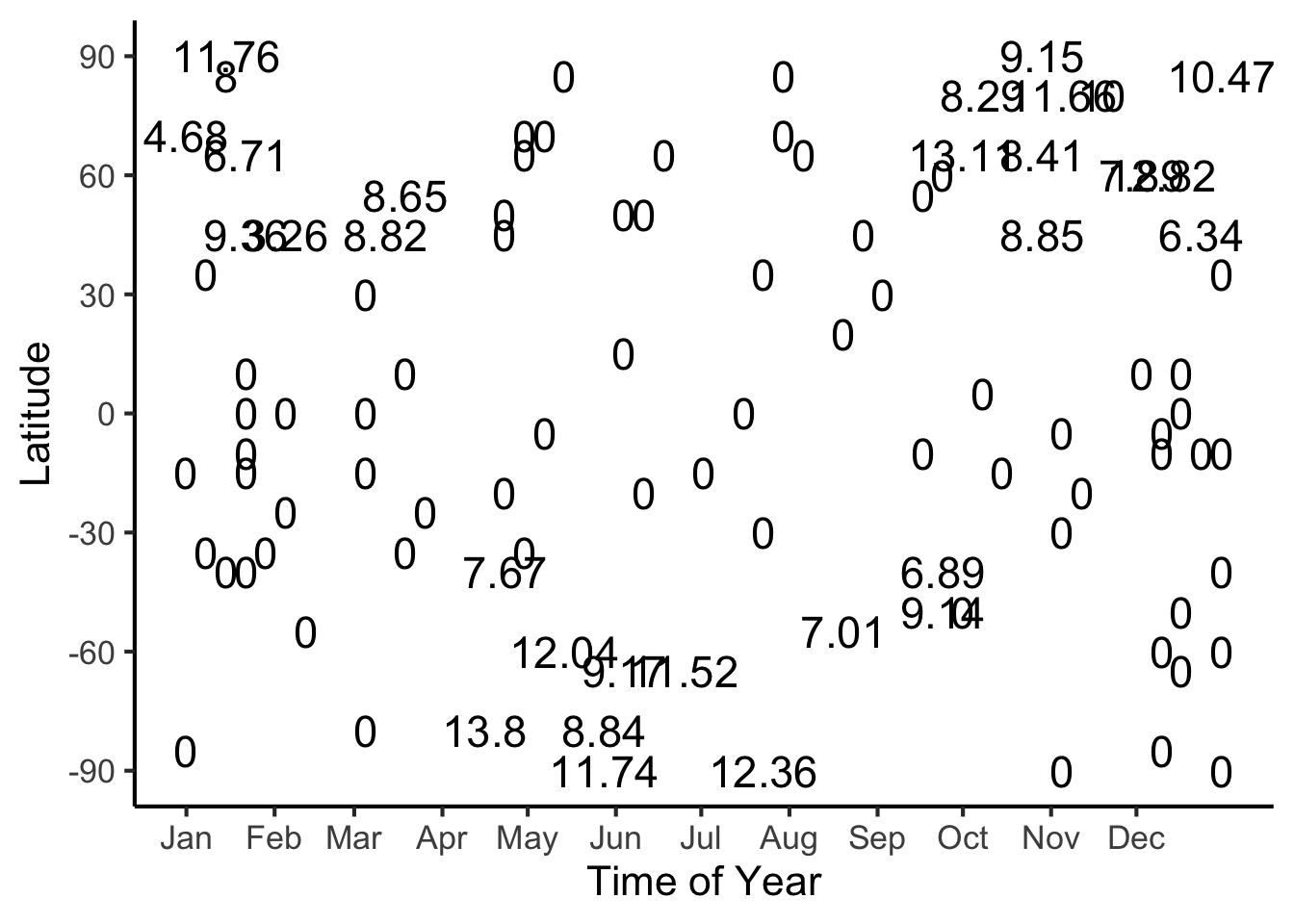
library(tidyverse)
library(latex2exp)
expr_pi2 <- TeX("$\\frac{\\pi}{2}$")
expr_pi <- TeX("$\\pi$")
expr_3pi2 <- TeX("$\\frac{3\\pi}{2}$")
expr_2pi <- TeX("$2\\pi$")
x_range <- 2 * pi
x_coords <- seq(0, x_range, by = x_range / 100)
num_x_coords <- length(x_coords)
data_df <- tibble(x = x_coords)
data_df <- data_df |> mutate(
y_raw = sin(x),
y_noise = rnorm(num_x_coords, 0, 0.15)
)
data_df <- data_df |> mutate(
y = y_raw + y_noise
)
#y_coords <- y_raw_coords + y_noise
#y_coords <- y_raw_coords
#data_df <- tibble(x = x, y = y)
reg_tree_plot <- ggplot(data_df, aes(x=x, y=y)) +
geom_point(size = g_pointsize / 2) +
dsan_theme("half") +
labs(
x = "Feature",
y = "Label"
) +
geom_vline(
xintercept = pi,
linewidth = g_linewidth,
linetype = "dashed"
) +
scale_x_continuous(
breaks=c(0,pi/2,pi,(3/2)*pi,2*pi),
labels=c("0",expr_pi2,expr_pi,expr_3pi2,expr_2pi)
)
reg_tree_plot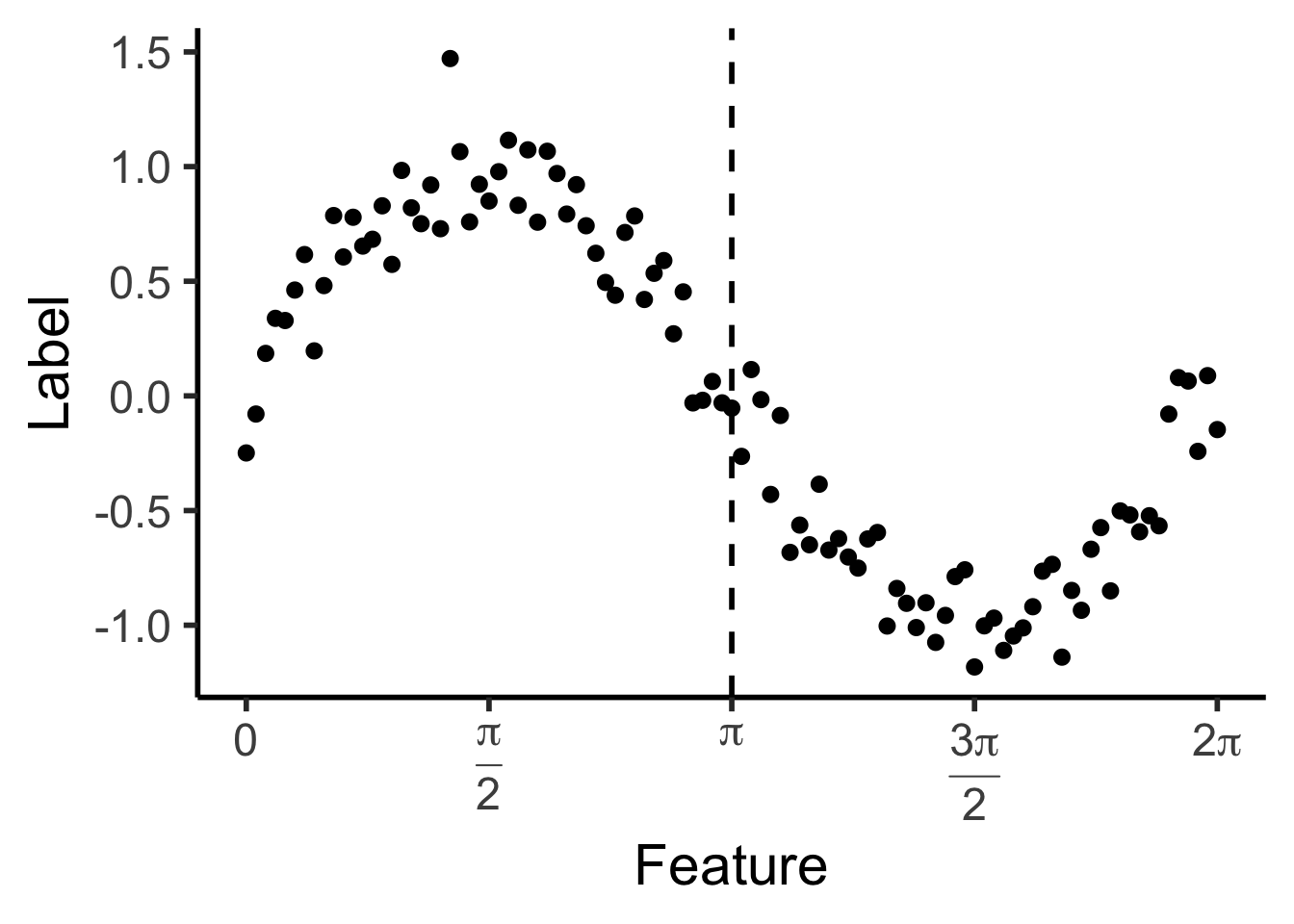
library(ggtext)
# x_lt_pi = data_df |> filter(x < pi)
# mean(x_lt_pi$y)
data_df <- data_df |> mutate(
pred_sq_err0 = (y - 0)^2
)
mse0 <- mean(data_df$pred_sq_err0)
mse0_str <- sprintf("%.3f", mse0)
reg_tree_plot +
geom_hline(
yintercept = 0,
color=cbPalette[1],
linewidth = g_linewidth
) +
geom_segment(
aes(x=x, xend=x, y=0, yend=y)
) +
geom_text(
aes(x=(3/2)*pi, y=0.5, label=paste0("MSE = ",mse0_str)),
size = 10,
#box.padding = unit(c(2,2,2,2), "pt")
)Warning in geom_text(aes(x = (3/2) * pi, y = 0.5, label = paste0("MSE = ", : All aesthetics have length 1, but the data has 101 rows.
ℹ Please consider using `annotate()` or provide this layer with data containing
a single row.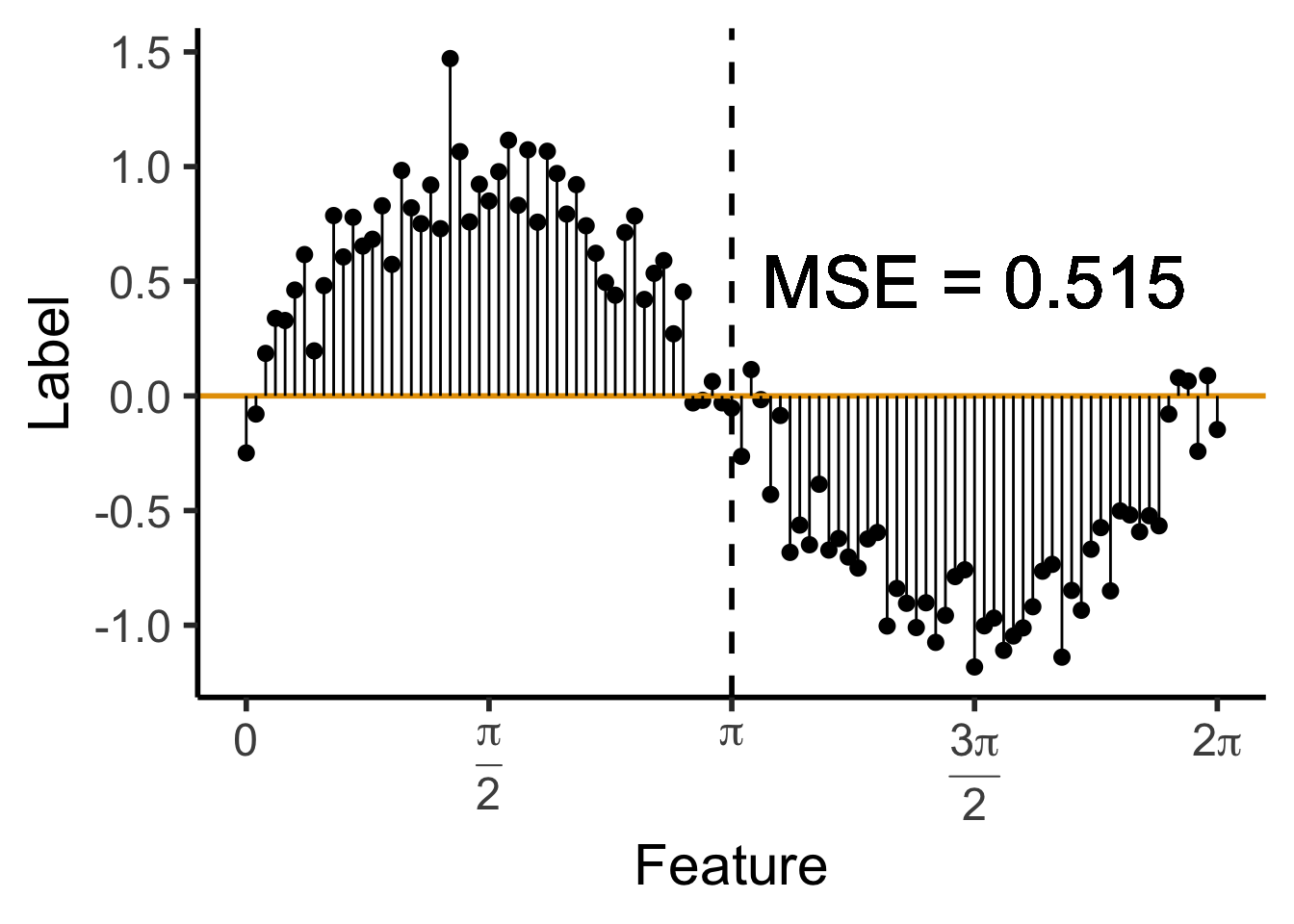
\[ \widehat{y}(x) = \begin{cases} \phantom{-}\frac{2}{\pi} &\text{if }x < \pi, \\ -\frac{2}{\pi} &\text{otherwise.} \end{cases} \]
get_y_pred <- function(x) ifelse(x < pi, 2/pi, -2/pi)
data_df <- data_df |> mutate(
pred_sq_err1 = (y - get_y_pred(x))^2
)
mse1 <- mean(data_df$pred_sq_err1)
mse1_str <- sprintf("%.3f", mse1)
decision_df <- tribble(
~x, ~xend, ~y, ~yend,
0, pi, 2/pi, 2/pi,
pi, 2*pi, -2/pi, -2/pi
)
reg_tree_plot +
geom_segment(
data=decision_df,
aes(x=x, xend=xend, y=y, yend=yend),
color=cbPalette[1],
linewidth = g_linewidth
) +
geom_segment(
aes(x=x, xend=x, y=get_y_pred(x), yend=y)
) +
geom_text(
aes(x=(3/2)*pi, y=0.5, label=paste0("MSE = ",mse1_str)),
size = 9,
#box.padding = unit(c(2,2,2,2), "pt")
)Warning in geom_text(aes(x = (3/2) * pi, y = 0.5, label = paste0("MSE = ", : All aesthetics have length 1, but the data has 101 rows.
ℹ Please consider using `annotate()` or provide this layer with data containing
a single row.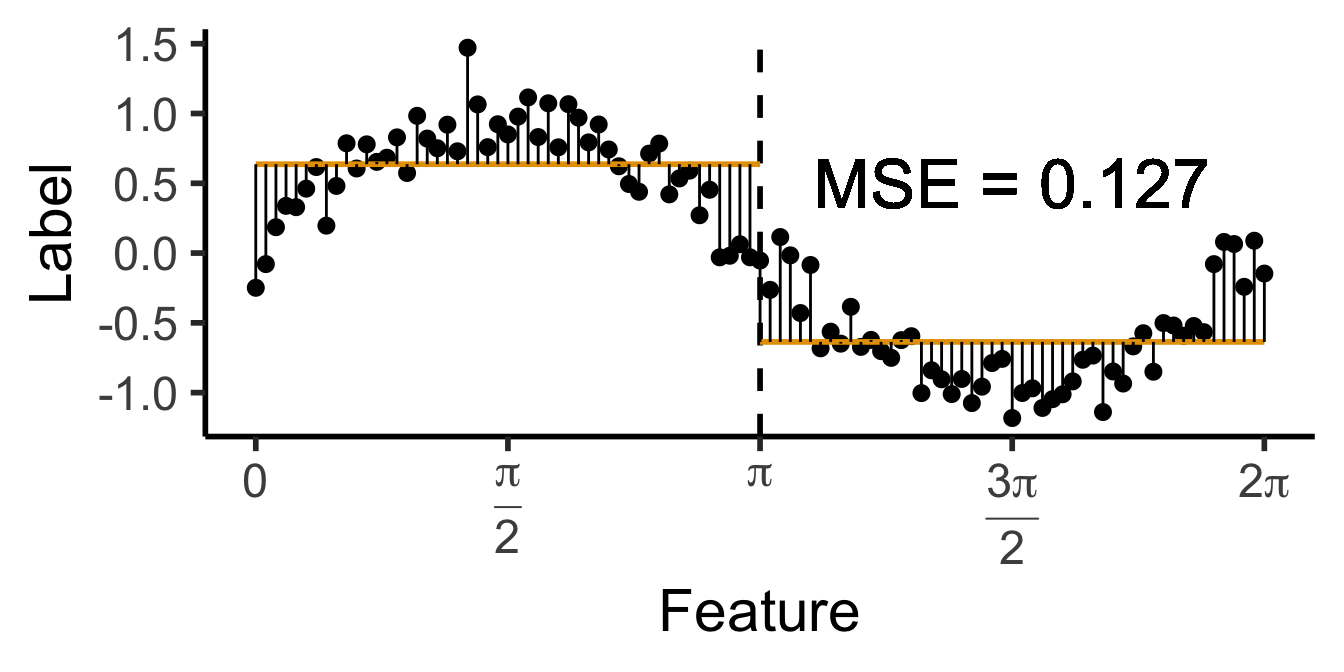
\[ \widehat{y}(x) = \begin{cases} \phantom{-}\frac{9}{4\pi} &\text{if }x < \frac{2\pi}{3}, \\ \phantom{-}0 &\text{if }\frac{2\pi}{3} \leq x \leq \frac{4\pi}{3} \\ -\frac{9}{4\pi} &\text{otherwise.} \end{cases} \]
cut1 <- (2/3) * pi
cut2 <- (4/3) * pi
pos_mean <- 9 / (4*pi)
get_y_pred <- function(x) ifelse(x < cut1, pos_mean, ifelse(x < cut2, 0, -pos_mean))
data_df <- data_df |> mutate(
pred_sq_err1b = (y - get_y_pred(x))^2
)
mse1b <- mean(data_df$pred_sq_err1b)
mse1b_str <- sprintf("%.3f", mse1b)
decision_df <- tribble(
~x, ~xend, ~y, ~yend,
0, (2/3)*pi, pos_mean, pos_mean,
(2/3)*pi, (4/3)*pi, 0, 0,
(4/3)*pi, 2*pi, -pos_mean, -pos_mean
)
reg_tree_plot +
geom_segment(
data=decision_df,
aes(x=x, xend=xend, y=y, yend=yend),
color=cbPalette[1],
linewidth = g_linewidth
) +
geom_segment(
aes(x=x, xend=x, y=get_y_pred(x), yend=y)
) +
geom_text(
aes(x=(3/2)*pi, y=0.5, label=paste0("MSE = ",mse1b_str)),
size = 9,
#box.padding = unit(c(2,2,2,2), "pt")
)Warning in geom_text(aes(x = (3/2) * pi, y = 0.5, label = paste0("MSE = ", : All aesthetics have length 1, but the data has 101 rows.
ℹ Please consider using `annotate()` or provide this layer with data containing
a single row.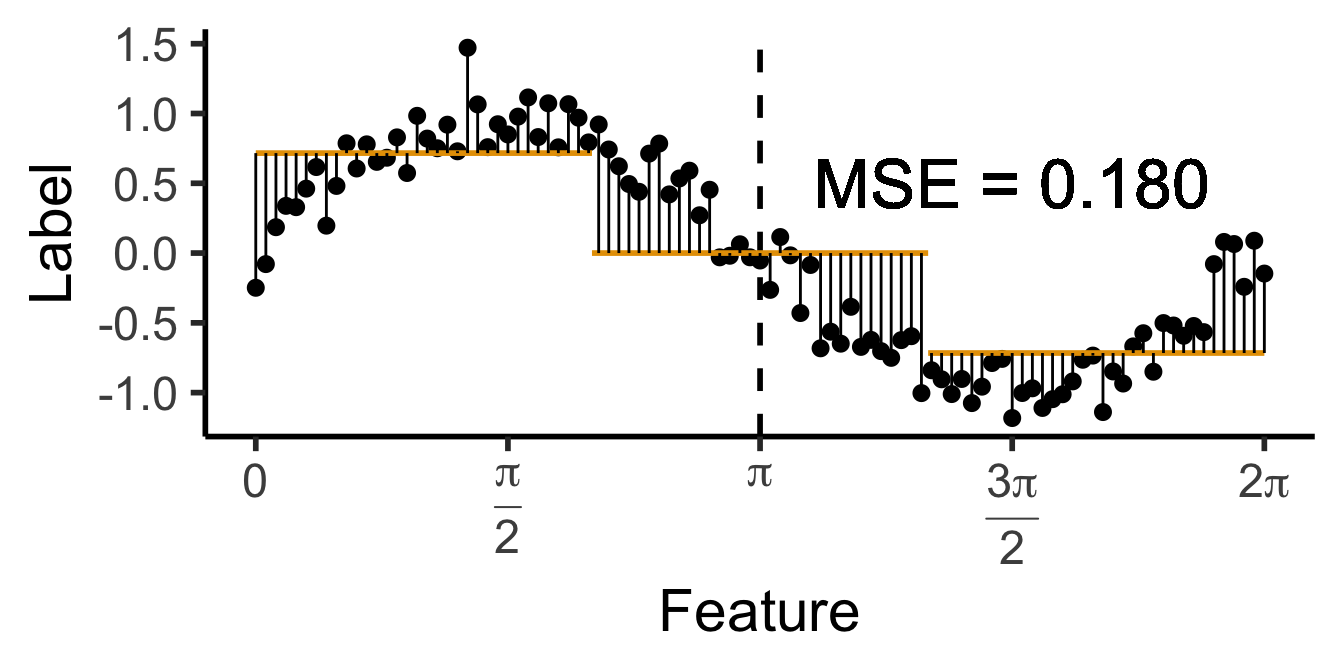
\[ \widehat{y}(x) = \begin{cases} \phantom{-}0.695 &\text{if }x < (1-c)\pi, \\ \phantom{-}0 &\text{if }(1-c)\pi \leq x \leq (1+c)\pi \\ -0.695 &\text{otherwise,} \end{cases} \]
with \(c \approx 0.113\), gives us:
c <- 0.113
cut1 <- (1 - c) * pi
cut2 <- (1 + c) * pi
pos_mean <- 0.695
get_y_pred <- function(x) ifelse(x < cut1, pos_mean, ifelse(x < cut2, 0, -pos_mean))
data_df <- data_df |> mutate(
pred_sq_err1b = (y - get_y_pred(x))^2
)
mse1b <- mean(data_df$pred_sq_err1b)
mse1b_str <- sprintf("%.3f", mse1b)
decision_df <- tribble(
~x, ~xend, ~y, ~yend,
0, cut1, pos_mean, pos_mean,
cut1, cut2, 0, 0,
cut2, 2*pi, -pos_mean, -pos_mean
)
reg_tree_plot +
geom_segment(
data=decision_df,
aes(x=x, xend=xend, y=y, yend=yend),
color=cbPalette[1],
linewidth = g_linewidth
) +
geom_segment(
aes(x=x, xend=x, y=get_y_pred(x), yend=y)
) +
geom_text(
aes(x=(3/2)*pi, y=0.5, label=paste0("MSE = ",mse1b_str)),
size = 9,
#box.padding = unit(c(2,2,2,2), "pt")
)Warning in geom_text(aes(x = (3/2) * pi, y = 0.5, label = paste0("MSE = ", : All aesthetics have length 1, but the data has 101 rows.
ℹ Please consider using `annotate()` or provide this layer with data containing
a single row.
DecisionTreeClassifier and DecisionTreeRegressor classes!\[ \mathbf{\Sigma}' = \mathbf{V}\mathbf{\Sigma}\mathbf{V}^{-1}. \]